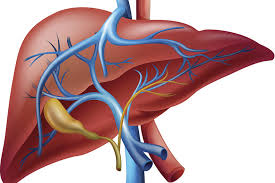
Liver and its amazing functions
In the digestive system, the liver is a very important organ and weighs about 1.5 kg, the largest weight of a single organ in our body. The liver has two large parts, called the right lobe and left lobe. The gallbladder is located under the liver, along with parts of the pancreas and intestines, working together to digest, absorb and process food.

The working cells of the liver are called liver cells. Liver cells have unique fertility in response to liver damage. Liver regeneration may occur after surgery to remove or damage a part of the liver. An University of Pittsburgh surgeon estimates that if the liver size is reduced to 25% -30%, it can still work and recover to its full original size.
The liver performs more than 500 tasks with the main role of removing toxins from the body, handling nutrients of food and helping regulate the body's metabolism.
As soon as the nutrient is processed, the liver is also a place to store glycogen, vitamins and minerals that when our body does not immediately ingest through the diet, the liver sends these substances into the bloodstream to our body so it an operate normally.
The liver also synthesizes plasma proteins, such as albumin and other clotting factors so that when we bleed from the wound, the blood will be held to heal.
So the liver is both a treatment plant and a repository of some nutrients
Liver detoxifies through two stages: Stage 1 and Stage 2:
At stage 1, the liver converts a toxic chemical into a less toxic chemical to be processed in Phase 2. This is achieved by various chemical reactions (such as oxidation, reduction and hydration), and in this process, free radicals are created, if excessive, can damage liver cells.
Stage 2 is called the conjugation pathway, whereby liver cells add another substance (eg amino acid, glycine, glutamine and choline) to a toxic chemical, to make it less harmful. This makes the toxin soluble in water, so it can be excreted from the body through fluids such as urine or bile (then passes through the intestine.)
Because of these important activities, the liver is under constant pressure and is one of the body's most easily damaged organs. A variety of factors can prevent liver from performing its important functions such as fat accumulation, alcohol abuse, viral infection, heavy metal accumulation, toxic substances, western medicines and liver cancer. Or the liver is also less effective when it lacks the necessary nutrients to detoxify at two stages.
In addition to minerals and vitamins BIO BODY BALANCE CLEANSE Probiotics provides antioxidant plant active ingredients and anti-free radicals to support and protect the liver during detoxification period 1; Green chlorophyll has the ability to bind heavy metals in the digestive system to help the liver push them out during the detoxification phase of the liver.
We believe that toxic substances in our bodies are not accumulated in a few days, but a long process, so when we need to eliminate them, we also need weeks to help the body to eliminate them scientifically and sustainably
Our digestive system is very intelligent and effective. If we take care of them properly, they are the best nutrient absorption and detoxification plant
Image source: www.hopkinsmedicine.org